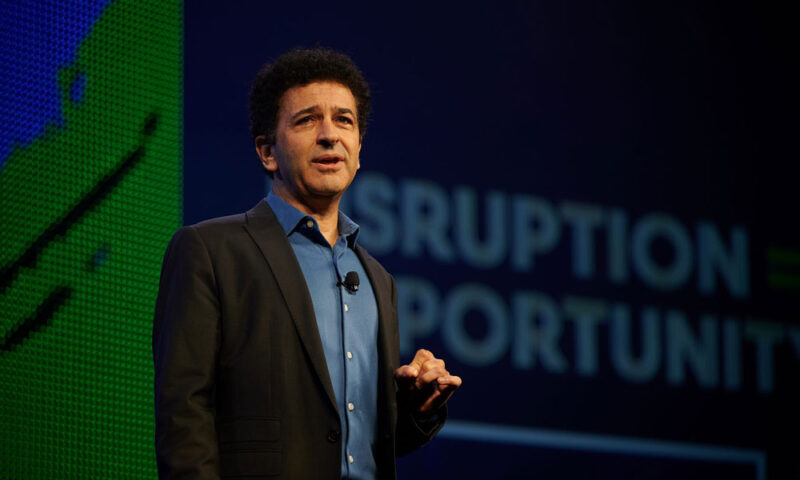
#ASAE22 Keynote: A Call to Experiment
During the #ASAE22 opening keynote on Sunday morning, former biotech CEO and author Safi Bahcall challenged attendees to test new ideas, large and small, and ignore the critics.
Don’t be afraid to run experiments. Even if you have to hide them from some of your board members.
Cultivating a willingness to try new things was Safi Bahcall’s central message during his opening keynote at the 2022 ASAE Annual Meeting & Expo. Bahcall, the cofounder and former CEO of the public biotech firm Synta Pharmaceuticals and author of the book Loonshots, spoke about how organizations can structure successful experiments—and what happens to organizations when they fail to do so.
“How do you become the initiator and not the victim of innovative surprise?” he asked attendees.
One example of those victims, he noted, was Circuit City, which through much of the 1990s was the nation’s leading electronics retailer before it was overtaken by Best Buy. Best Buy pulled ahead, Bahcall said, because it created a culture that was open to more innovative retail ideas and was willing to test new concepts even if they failed. “Best Buy ran experiments,” he said. “Circuit City was governed by opinions.”
But even organizations that claim to be experimenters can still fall short. Bahcall cited three main reasons for that: A fear of failure that shames the people who come up with ideas that don’t take off; a bureaucracy that makes it hard to launch experiments; and a lack of a framework to support the ideas that people come up with.
Bahcall discussed five keys for successful innovation to avoid those mistakes.
First, celebrate “good fails.” Even ideas that don’t take off can provide meaningful information. Amazon’s history is littered with failures, which Bahcall said was one reason why it thrives. Consider its Fire Phone, which was criticized by many pundits when it was launched in 2014, found few users, and was swiftly discontinued. However, the Fire Phone taught Amazon that it was in the business of delivering value to customers, not luxury items. More importantly, it helped Amazon develop the voice-recognition technology that led to Alexa, a hit for the company.
How do you become the initiator and not the victim of innovative surprise?
Safi Bahcall
Second, avoid the idea of the CEO as a singular leader who is the sole shepherd and generator of brilliant ideas. Rather than being a “Moses” proclaiming wisdom from a mountaintop, the CEO should be a “gardener” who helps coordinate ideas and takes away roadblocks from experiments.
Third, work to strike a balance between people with big-picture, even unusual ideas (who he calls “artists”) with the more pragmatic, rigorous, and detail-focused people (who he calls “soldiers”). Favoring one group or the other can lead to good ideas slipping through the cracks. Indeed, a good leader should cultivate a healthy exchange between those groups that can lead to improvements.
Fourth, manage a supply of experiments that are adjacent to your core mission and some that might initially seem off-point. Think of Google, Bahcall said: Image search was a sensible new idea related to its roots as a search engine; but Gmail and Android were hits as well, even if Google wasn’t launched as an email or phone-technology business. If boards are skeptical about this kind of experimenting, he said, it can be pitched to them as a kind of “disruption insurance”—a way to fend off the kinds of outside challenges that can damage an organization.
Fifth, and most provocatively, Bahcall said creating urgency around an experiment is more important than letting everybody in on what you’re doing. With every experiment, he said, it’s important to identify allies, skeptics, and blockers. More conservative and risk-averse board members can be quick to shut down an idea or doom it to years of discussion. It’s more important to keep ideas churning, not to inform every board member about them: “Once you have the data from real experiments, you can convince the skeptics,” he said.
After his presentation, Bahcall participated in a Q&A with Sheri Sesay-Tuffour, Ph.D., CAE, CEO of the Pediatric Nursing Certification Board, and an ASAE board member. During their discussion, he emphasized that experiments don’t have to be wide-reaching or expensive. For instance, he recommended that organizations get out of the business of running “innovation competitions,” because they generate lots of big ideas that can’t all be taken on, thus demoralizing staff.
“Instead, do something in the middle,” he said—five-week experiments that can be done on a $500 budget. “You can run all of those. That creates a culture of experimenters and an energy of experimentation within your organization.”
Bahcall closed by challenging attendees to try running an experiment every day for a month—trying something new, personally and professionally. “See how you feel,” he said. “It will be a habit that will stick.”
(Nick Hagen Photography)






Comments